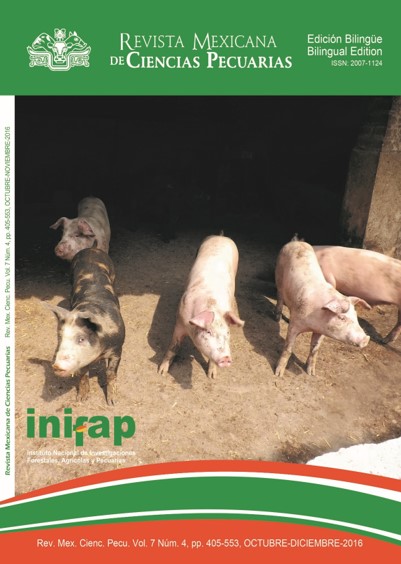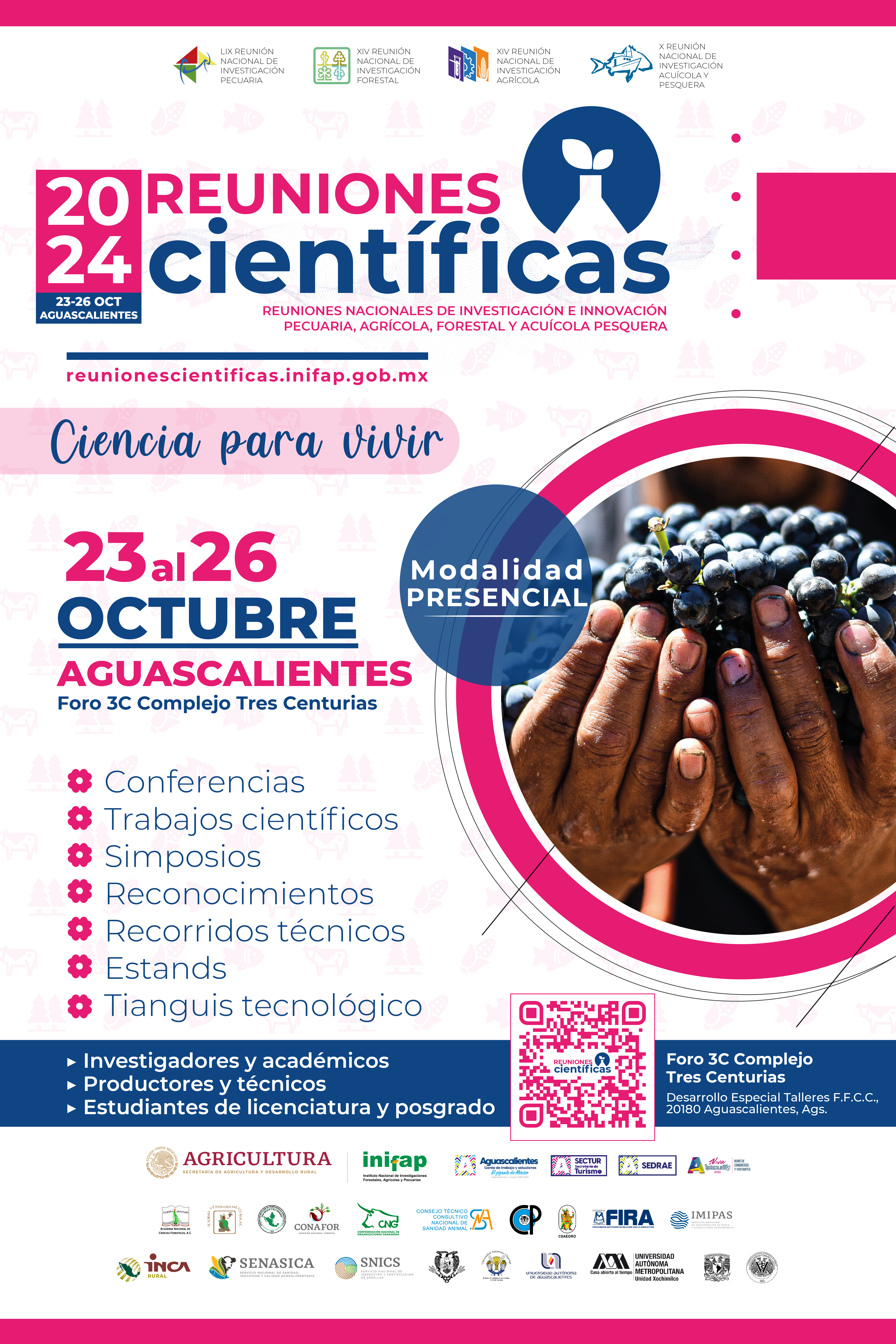Modification of a guanidinium thiocyanate to extract DNA from semen for genomic analysis in mammals
DOI:
https://doi.org/10.22319/rmcp.v7i4.4273Keywords:
Genomic DNA, DNA extraction, Semen, Mammals.Abstract
The genomic and transcriptomic analyses for selection and genetic improvement require DNA or RNA of hig concentration and purity, coming from different tissues, including semen. The DNA may be from hair, saliva, cartilage, blood, or semen. The methods usually used to extract DNA from semen have low efficiency in terms of quantity and quality. This is due to the solvents and dilutors used for semen conservation, physical and chemical characteristics of sperms, and non-cellular fraction of ejaculate. In this study, modifications to the guanidinium thiocyanate method are proposed, including a second washing of the sample using a phosphate buffer solution, and two washing with organic solvents, one strong (phenol:chloroform:Isoamyl alcohol), and one weak (chloroform:isoamyl alcohol), to get rid of the protein and dilutors present in the sample. Additionally, it is proposed a separate incubation with RNA-ase to reduce contamination of nucleic acids during measurement and dilution preparation for PCR amplification. The precipitation added to the isopropanol of the original method 3 M sodium acetate to separate the residuals of potential PCR inhibitors. Finally, there were included high-speed centrifugation and decantation to avoid the need for mechanical separation of the DNA and protein. The DNA extracted with the modified method did not present degradation, and the quality and quantity were better (P<0.0001) than the original, with a mean of 1.84±0.09 in the range of 260/ 280 and 156.99±7.29 ng/l for concentration. The present method of extraction is a viable low-cost alternative to obtain DNA from semen with the necessary characteristics for genomic analysis in mammals.
The genomic and transcriptomic analyses for selection and genetic improvement require DNA or RNA of hig concentration and purity, coming from different tissues, including semen. The DNA may be from hair, saliva, cartilage, blood, or semen. The methods usually used to extract DNA from semen have low efficiency in terms of quantity and quality. This is due to the solvents and dilutors used for semen conservation, physical and chemical characteristics of sperms, and non-cellular fraction of ejaculate. In this study, modifications to the guanidinium thiocyanate method are proposed, including a second washing of the sample using a phosphate buffer solution, and two washing with organic solvents, one strong (phenol:chloroform:Isoamyl alcohol), and one weak (chloroform:isoamyl alcohol), to get rid of the protein and dilutors present in the sample. Additionally, it is proposed a separate incubation with RNA-ase to reduce contamination of nucleic acids during measurement and dilution preparation for PCR amplification. The precipitation added to the isopropanol of the original method 3 M sodium acetate to separate the residuals of potential PCR inhibitors. Finally, there were included high-speed centrifugation and decantation to avoid the need for mechanical separation of the DNA and protein. The DNA extracted with the modified method did not present degradation, and the quality and quantity were better (P<0.0001) than the original, with a mean of 1.84±0.09 in the range of 260/ 280 and 156.99±7.29 ng/l for concentration. The present method of extraction is a viable low-cost alternative to obtain DNA from semen with the necessary characteristics for genomic analysis in mammals.
Downloads
References
Manuja A, Manchanda S, Kumar B, Khanna S, Sethi RK. Evaluation of different methods of DNA extraction from semen of buffalo (Bubalus bubalis) bulls. Buffalo Bull 2010;29(2):109-128.
Weyrich A. Preparation of genomic DNA from mammalian sperm. Current Protoc Mol Biol 2012;2(2.13):1-3.
Griffin J. Methods of sperm DNA extraction for genetic and epigenetic studies. Spermatogenesis. Methods Protoc 2013;927:379-384.
Van Kooij RJ, Van Oost BA. Determination of sex ratio of spermatozoa with a deoxyribonucleic acid-probe and quinacrine staining: a comparison. Fertil Steril
;58:384- 386.
Evenson D, Jost L. Sperm chromatin structure assay: DNA denaturability. Methods Cell Biol 1994;42:159-176.
Mann T. The biochemistry of semen. New York, USA: John Wiley and Sons, Inc; 1954.
Opel KL, Chung D, McCord B. A study of PCR inhibition mechanisms using real time. J Foren Sci 2009;55:25-33.
Herold FC, de Haas K, Cooper D, Colenbrander B, Nöthling JO, Theunisen W, et al. Comparison of three different media for freezing of epididymal sperm from the African buffalo (Syncerus caffer) and influence of equilibration time on the post-thaw sperm quality. Onderstepoort J Vet Res 2004;71:203-210.
Rådström P, Knutsson R, Wolffs P, Lövenklev M, Löfström C. Pre-PCR processing. Strategies to generate PCR-compatible samples. Mol Biotechnol 2004;26:133-146.
Hossain AM, Rizk B, Behzadian A, Thorneycroft JH. Modified guanidinium thiocyanate method for human sperm DNA isolation. Mol Hum Reprod 1997;3(11):953-956.
Bahnak BR, Wu QY, Coulombel L, Drouet L, Kerbiriou-Nabias D, Meyer D. A simple and efficient method for isolating high molecular weight DNA from mammalian sperm. Nucleic Acids Res 1988;16:1208-1209.
Birren B, Green ED, Klapholz S, Myers RM, Roskans J. Standard methods used for isolating DNA. In: Genome analysis: A laboratory manual. New York, USA: Cold Spring Harbor Laboratory Press; 1997:617-629.
SAS. SAS/STAT User´s Guide (Release 9.3). SAS Inst. Inc. Cary, N.C. 2014.
Sambrook J, Fritsch EF, Maniatis T. Molecular cloning: A laboratory manual. 2nd ed. New York, USA: Cold Spring Harbor Laboratory Press; 1990.
Downloads
Published
How to Cite
-
Abstract1698
-
PDF (Español)2454
Issue
Section
License

This work is licensed under a Creative Commons Attribution-NonCommercial-ShareAlike 4.0 International License.






